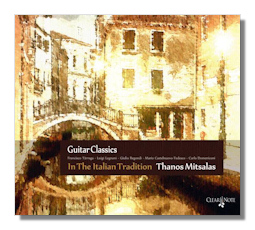
The Internet's Premier Classical Music Source
Related Links
-
Castelnuovo-Tedesco Reviews
Tárrega Reviews - Latest Reviews
- More Reviews
-
By Composer
-
Collections
DVD & Blu-ray
Books
Concert Reviews
Articles/Interviews
Software
Audio
Search Amazon
Recommended Links
Site News
 CD Review
CD Review
Guitar Classics

In the Italian Tradition
- Francisco Tárrega:
- Variations on the theme "Carnevale de Venezia"
- Luigi Legnani: Fantasia, Op. 19
- Mario Castelnuovo-Tedesco: Capriccio Diabolico
- Giulio Regondi:
- Nocturne "Rêverie," Op. 9
- Introduction & Caprice, Op. 23
- Carlo Domeniconi: Koyunbaba - Suite, Op. 19
Thanos Mitsalas, guitar
Clear Note 74575 DDD 63:16
As far as the guitar is concerned, I'm not sure there is an "Italian tradition" as much as there is a rich history of Italians writing music for and playing the guitar. (Do we speak of the "pasta tradition," after all?) Greek guitarist Thanos Mitsalas's new CD explores that "tradition" with most enjoyable results. It opens not with an Italian composer, however, but with one from Spain – the colorful Francisco Tárrega, who was active as a guitarist and composer during the latter part of the 19th century. Apparently no one knows who wrote The Carnival of Venice, but it is has been the theme for variations written by a number of composers, including Paganini (for violin) and Johann Kaspar Mertz (another version for guitar). In their increasing difficulty, Tárrega's variations seem to have been inspired by Paganini's, but Mitsalas seems unfazed by at all, spinning out the ever more complicated figurations almost nonchalantly.
The long-lived Legnani (1790-1877) was not only a guitarist, but also a tenor, who sang in operas by Rossini, and others. He too was inspired by Paganini, and even wrote a set of Caprices for guitar. After a grave introduction, his Fantasia takes off on a charming flight of fancy that doesn't sound unlike something that Rossini might have composed, had he composed for the guitar.
Castelnuovo-Tedesco came to the United States in 1939 as a result of increasing anti-Semitism in his homeland. This Capriccio diabolico dates from 1934, and also was inspired by Paganini – including by that composer-violinist's rumored pact with the devil! In the United States, Castelnuovo-Tedesco's pupils included film composer John Williams (not the guitarist by that name!). Some of Castelnuovo-Tedesco's concert music sounds like John Williams, although of course it really should be the other way around. The Capriccio diabolico, however, really is steeped in the "Italian tradition." It is most diabolical in the way that it heaps one difficulty upon another for the performer. Again, Mitsalas copes with it all with a smoothness that seems, well, almost devilish.
Although his music has been given a new lease on life in recent years, Giulio Regondi is something of a mystery. Not very much seems to be known about him – there are even questions about the precise date and place of his birth. (He was, however, born in 1822.) Many of his later works were composed for concertina. The two guitar works recorded here quickly entered the repertory of (advanced) guitarists when they were recently rediscovered. The Nocturne "Rêverie" is wistful throughout, and its relaxed melodic bent certainly suggests Italy. The booklet notes describe it as "perhaps the greatest tremolo piece written for the instrument," and if it fatigues Mitsalas, there is no hint of that in this performance. The Introduction and Caprice also has a low-key charm. Regondi may have been a virtuoso, and these two works may be difficult to play, but the emphasis here is on a singing line and on creating a sense of comfort and ease. Here, Mitsalas shows that he can play in a warm, cantabile style; he's not just a dazzler.
Carlo Domeniconi is in his sixties, and his "greatest hit" probably is this four-movement suite. Koyunbaba means "sheep father," which is another way of saying "shepherd." It was inspired by Domeniconi's travels in Turkey. "Koyunbaba" is also a family name – there was an actual Koyunbaba in the 1200s – and some believe that the land on which he lived and worked is bewitched; many outsiders who have attempted to settle upon it apparently have become ill! Domeniconi's suite could be a curse on unprepared guitarists; it is highly demanding. Again, Mitsalas has it all under control. He aptly conveys the music's mystery and legendary qualities, and generates a good deal of intensity. The final Presto is unbelievable, in its speed and clarity.
Mitsalas has been given excellent engineering, although some of the tracks cut off too quickly, robbing some of the decay from the guitar's final notes. The booklet notes give a good introduction to the repertory, but they needed a good editor.
Copyright © 2012, Ray Tuttle




















